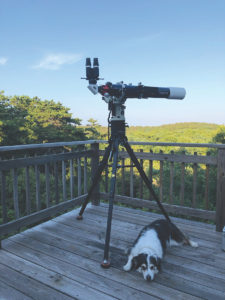
A few nights ago, I stood on a deck in Truro that looked east over the National Seashore. In the distance, I could hear the Atlantic surf; from the opposite direction I heard an occasional loud car roaring up Route 6. The house had a high vantage, and, looking up at the night sky, I had a clear view of the stars in all directions.
In the northwest, I found Ursa Major — the Big Dipper. To the left, along an arc implied by the Big Dipper’s handle, was the bright orange star Arcturus. And because I had done a little internet research earlier that day, I knew that somewhere below Arcturus I could find Comet NEOWISE.
The comet’s full name is C/2020 F3 (NEOWISE). It was discovered in March by NASA’s Wide-field Infrared Survey Explorer (WISE) space telescope, as part of its Near-Earth Object (NEO) detection program.
Like all comets, it’s a “dirty snowball” — a conglomeration of ice, dust, and rock, in this case, about three miles in diameter. This one orbits once every 6,800 years or so; as it draws near the Sun from the frigid outer reaches of the solar system and warms, its ice begins to sublimate, that is, transition directly from solid to gas. That’s what creates the glowing halo that we can see from Earth, and the comet’s tail. And the sublimation of this ice — the glue that holds the comet together — releases some of the dust and rock, creating a debris trail as the comet speeds along.
NEOWISE made its closest approach to Earth on July 23 at a distance of 64 million miles. Throughout July, you could see it under dark skies with the unaided eye. But now, after rounding the Sun and passing us by, the comet grows dimmer each night as it heads back out on its long orbit.
Standing on the deck, I knew it would not be easy to find. I waited for my eyes to adapt to the darkness. When my family turned on the outdoor lights to see if I was there, I covered my eyes and yelled at them to turn the lights off. As I waited a little longer and my night vision grew more acute, I scanned back and forth below Arcturus.
Then, there it was: a small, faint, hazy patch in the sky. It was so dim that I couldn’t see it directly. I had to use averted vision: an observation technique that amateur astronomers use to compensate for the fact that the human eye is less sensitive to dim light in the center of our vision, and much more sensitive in our peripheral vision.
By looking just to one side of the comet, but at the same time focusing my attention on my peripheral vision, the faint form of the comet popped into view. It was a fuzzy blob, quite distinct from the pinpoint stars around it, and I could see a ghostly hint of its tail.
By chance, that night was also when the annual Perseid meteor shower reached its peak. Perseid meteors streaked across the sky every few minutes; some left glowing trails or exploded in brilliant bursts of light. It was a serendipitous conjunction of two celestial events that were unrelated, but which together created a satisfying harmony: there was Comet NEOWISE, shedding a debris trail of dust and tiny pebbles, and there were the Perseids, the dust and tiny pebbles from a different comet, burning up in our atmosphere, which happens as Earth passes through that other comet’s debris trail every August.
By the time you read this, the Perseids will be over and NEOWISE will be even harder to see (you’ll need binoculars and averted vision); soon it will vanish from sight. Both received a lot of attention in the news and on social media, perhaps more than they might have in other years; but right now, we tend to look for meaning in things. The Perseids lit up the sky like fireworks, as if in celebration of something. Maybe it was the lives of those we have lost this year, and those we might still lose.
And NEOWISE? To me, the comet seemed to say, Hello, humanity! I know it’s hard right now, but you’ve come a long way since I last saw you in 4780 BCE. Hang in there!
When the year 8820 comes around, I like to think someone will be here to greet NEOWISE on its return. And if NEOWISE asks how humanity is doing, maybe they’ll reply, Much better now, thanks.
